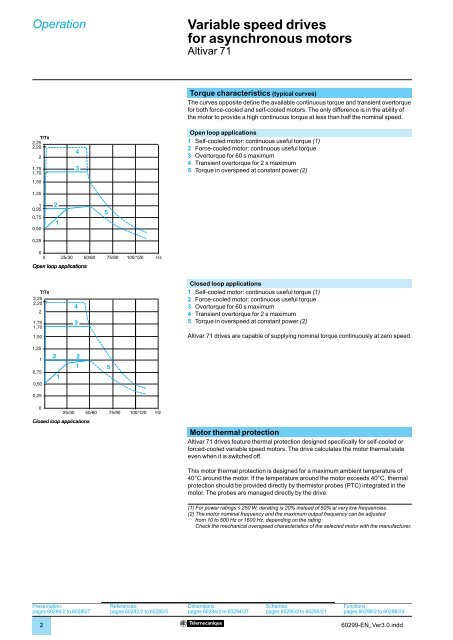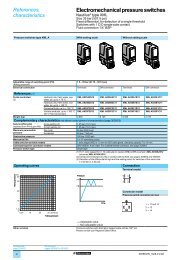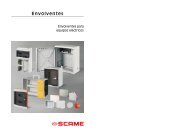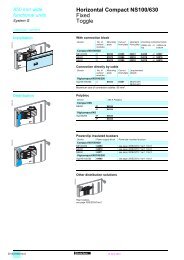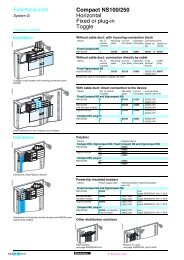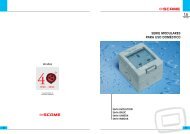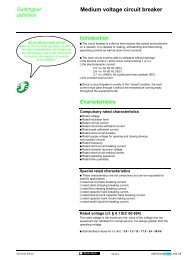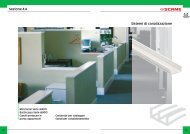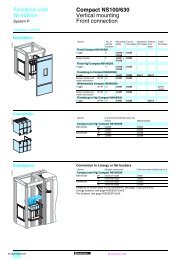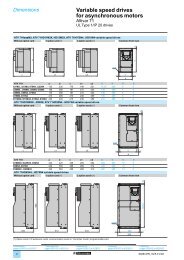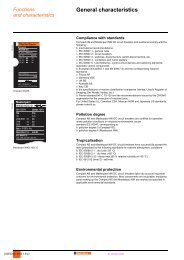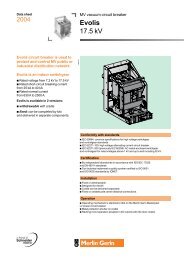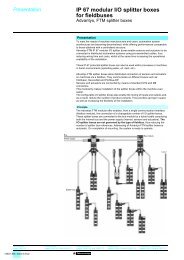Variable speed drives for asynchronous motors
Variable speed drives for asynchronous motors
Variable speed drives for asynchronous motors
You also want an ePaper? Increase the reach of your titles
YUMPU automatically turns print PDFs into web optimized ePapers that Google loves.
Operation<br />
<strong>Variable</strong> <strong>speed</strong> <strong>drives</strong><br />
<strong>for</strong> <strong>asynchronous</strong> <strong>motors</strong><br />
Altivar 71<br />
T/Tn<br />
2,25<br />
2,20<br />
2<br />
1,75<br />
1,70<br />
1,50<br />
1,25<br />
4<br />
3<br />
Torque characteristics (typical curves)<br />
The curves opposite defi ne the available continuous torque and transient overtorque<br />
<strong>for</strong> both <strong>for</strong>ce-cooled and self-cooled <strong>motors</strong>. The only difference is in the ability of<br />
the motor to provide a high continuous torque at less than half the nominal <strong>speed</strong>.<br />
Open loop applications<br />
1 Self-cooled motor: continuous useful torque (1)<br />
2 Force-cooled motor: continuous useful torque<br />
3 Overtorque <strong>for</strong> 60 s maximum<br />
4 Transient overtorque <strong>for</strong> 2 s maximum<br />
5 Torque in over<strong>speed</strong> at constant power (2)<br />
1<br />
0,95<br />
0,75<br />
0,50<br />
0,25<br />
2<br />
1<br />
5<br />
0<br />
0 25/30 50/60 75/90 100/120<br />
Open loop applications<br />
Hz<br />
T/Tn<br />
2,25<br />
2,20<br />
2<br />
1,75<br />
1,70<br />
1,50<br />
4<br />
3<br />
Closed loop applications<br />
1 Self-cooled motor: continuous useful torque (1)<br />
2 Force-cooled motor: continuous useful torque<br />
3 Overtorque <strong>for</strong> 60 s maximum<br />
4 Transient overtorque <strong>for</strong> 2 s maximum<br />
5 Torque in over<strong>speed</strong> at constant power (2)<br />
Altivar 71 <strong>drives</strong> are capable of supplying nominal torque continuously at zero <strong>speed</strong>.<br />
1,25<br />
1<br />
0,75<br />
0,50<br />
2<br />
1<br />
2<br />
1<br />
5<br />
0,25<br />
0<br />
25/30 50/60 75/90 100/120 Hz<br />
Closed loop applications<br />
Motor thermal protection<br />
Altivar 71 <strong>drives</strong> feature thermal protection designed specifi cally <strong>for</strong> self-cooled or<br />
<strong>for</strong>ced-cooled variable <strong>speed</strong> <strong>motors</strong>. The drive calculates the motor thermal state<br />
even when it is switched off.<br />
This motor thermal protection is designed <strong>for</strong> a maximum ambient temperature of<br />
40°C around the motor. If the temperature around the motor exceeds 40°C, thermal<br />
protection should be provided directly by thermistor probes (PTC) integrated in the<br />
motor. The probes are managed directly by the drive.<br />
(1) For power ratings ≤ 250 W, derating is 20% instead of 50% at very low frequencies.<br />
(2) The motor nominal frequency and the maximum output frequency can be adjusted<br />
from 10 to 500 Hz or 1600 Hz, depending on the rating.<br />
Check the mechanical over<strong>speed</strong> characteristics of the selected motor with the manufacturer.<br />
Presentation:<br />
pages 60280/2 to 60280/7<br />
References:<br />
pages 60282/2 to 60282/5<br />
Dimensions:<br />
pages 60294/2 to 60294/27<br />
Schemes:<br />
pages 60295/2 to 60295/21<br />
Functions:<br />
pages 60298/2 to 60298/33<br />
2<br />
60299-EN_Ver3.0.indd
Operation (continued)<br />
<strong>Variable</strong> <strong>speed</strong> <strong>drives</strong><br />
<strong>for</strong> <strong>asynchronous</strong> <strong>motors</strong><br />
Altivar 71<br />
Special uses<br />
Using Altivar 71 <strong>drives</strong> with synchronous <strong>motors</strong><br />
Altivar 71 <strong>drives</strong> are also suitable <strong>for</strong> powering synchronous <strong>motors</strong> (sinusoidal<br />
electromotive <strong>for</strong>ce) in open loop mode and are used to achieve per<strong>for</strong>mance<br />
levels comparable to those associated with an <strong>asynchronous</strong> motor in<br />
sensorless fl ux vector control.<br />
This drive/motor combination makes it possible to obtain remarkable <strong>speed</strong><br />
accuracy and maximum torque even at zero <strong>speed</strong>. The design and construction<br />
of synchronous <strong>motors</strong> are such that they offer enhanced power density and<br />
<strong>speed</strong> dynamics in a compact unit. Drive control <strong>for</strong> synchronous <strong>motors</strong> does<br />
not cause stalling.<br />
Using special <strong>motors</strong> at high-<strong>speed</strong><br />
These <strong>motors</strong> are designed <strong>for</strong> constant torque applications with high frequency<br />
ranges. The Altivar 71 drive supports operating frequencies of up to 1600 Hz. By<br />
design, this type of motor is more sensitive to overvoltages than a standard motor.<br />
Various solutions are available:<br />
b Overvoltage limitation function<br />
b Output filters<br />
The drive’s 5-point voltage/frequency control ratio is particularly well-suited as it<br />
avoids resonance.<br />
0,95 1 T/Tn<br />
1<br />
0,75<br />
3<br />
0,50<br />
2<br />
0,25<br />
0<br />
0<br />
25/30<br />
50/60<br />
75/90<br />
100/120<br />
Hz<br />
Using a motor at over<strong>speed</strong><br />
Using a motor at over<strong>speed</strong><br />
The maximum output frequency of the drive can be adjusted from 10 to 1600 Hz <strong>for</strong><br />
<strong>drives</strong> rated less than or equal to 37 kW and from 10 to 500 Hz <strong>for</strong> higher ratings.<br />
When using a standardized <strong>asynchronous</strong> motor at over<strong>speed</strong>, check the mechanical<br />
over<strong>speed</strong> characteristics of the selected motor with the manufacturer.<br />
Above its nominal <strong>speed</strong> corresponding to a frequency of 50/60 Hz, the motor<br />
operates with a decreasing fl ux, and its torque decreases signifi cantly (see curve<br />
opposite).<br />
The application must be able to permit this type of low-torque, high-<strong>speed</strong> operation.<br />
1 Machine torque (degressive torque)<br />
2 Machine torque (low motor torque)<br />
3 Continuous motor torque<br />
Typical applications: wood-working machinery, broaching machines,<br />
high-<strong>speed</strong> hoisting, etc.<br />
Motor power less than drive power<br />
The Altivar 71 can power any motor which has a rating lower than that <strong>for</strong> which the<br />
drive was designed. This motor/drive combination makes it suitable <strong>for</strong> applications<br />
requiring high, intermittent overtorque.<br />
Typical applications: machines with very high starting torque, grinders,<br />
kneaders, etc.<br />
Note: In this case, it is advisable to over-rate the drive to the next standard power rating<br />
immediately above that of the motor.<br />
Example: Use an 11 kW motor with a 15 kW drive.<br />
I/In motor<br />
1,25<br />
0,95 1<br />
0,75<br />
0,50<br />
0,25<br />
2<br />
1<br />
2<br />
1<br />
Power of a self-cooled motor greater than the drive power<br />
This motor-drive combination makes it possible to use a self-cooled motor <strong>for</strong><br />
a greater <strong>speed</strong> range in continuous operation. The use of a motor with a higher<br />
power rating than that of the drive is only possible if the current drawn by this motor<br />
is lower than or equal to the nominal drive current.<br />
Note: Limit the motor power to the standard rating immediately above that of the drive.<br />
Example: On a single machine, the use of a 2.2 kW drive combined with a 3 kW<br />
motor means that the machine can operate at its nominal power (2.2 kW) at<br />
low <strong>speed</strong>.<br />
1 Motor power = drive power = 2.2 kW<br />
2 2.2 kW drive combined with a 3 kW motor: greater <strong>speed</strong> range at 2.2 kW.<br />
0<br />
0<br />
10/12<br />
25/30<br />
50/60 Hz<br />
Power of a self-cooled motor greater than the drive power<br />
Presentation:<br />
pages 60280/2 to 60280/7<br />
References:<br />
pages 60282/2 to 60282/5<br />
Dimensions:<br />
pages 60294/2 to 60294/27<br />
Schemes:<br />
pages 60295/2 to 60295/21<br />
Functions:<br />
pages 60298/2 to 60298/33<br />
60299-EN_Ver3.0.indd<br />
3
Operation (continued)<br />
<strong>Variable</strong> <strong>speed</strong> <strong>drives</strong><br />
<strong>for</strong> <strong>asynchronous</strong> <strong>motors</strong><br />
Altivar 71<br />
Altivar 71<br />
Output<br />
fi lter<br />
In1<br />
In2<br />
M1<br />
M2<br />
Special uses (continued)<br />
Connecting <strong>motors</strong> in parallel<br />
The nominal current of the drive must be greater than or equal to the sum of the<br />
currents of the <strong>motors</strong> to be controlled.<br />
In this case, provide external thermal protection <strong>for</strong> each motor using probes or<br />
thermal overload relays. For cable runs over a certain length, taking account of all<br />
the tap links, it is advisable either to install an output fi lter between the drive and the<br />
<strong>motors</strong> or to use the overvoltage limitation function.<br />
In drive > In1 + In2 +…Inx<br />
Connecting <strong>motors</strong> in parallel<br />
Inx<br />
Mx<br />
If several <strong>motors</strong> are used in parallel, there are 2 possible scenarios:<br />
b The <strong>motors</strong> have equal power ratings, in which case the torque characteristics will<br />
remain optimized after the drive has been confi gured<br />
b The <strong>motors</strong> have different power ratings, in which case the torque characteristics<br />
will not be optimized <strong>for</strong> all the <strong>motors</strong><br />
Altivar 71<br />
2,2 kW<br />
Altivar 71<br />
4 kW<br />
2,2 kW<br />
1500 tr/min<br />
Identical<br />
motor<br />
3,8 kW<br />
2600 tr/min<br />
50 Hz<br />
Δ 87 Hz<br />
Using a motor at constant torque up to 87/104 Hz<br />
A 400 V, 50 Hz motor in connection can be used at constant torque up to 87 Hz<br />
if it is in Δ connection.<br />
In this particular case, the initial motor power and the power of the fi rst associated<br />
drive are multiplied by 3 (it is there<strong>for</strong>e important to select a drive with a suitable<br />
rating).<br />
Example: A 2.2 kW 50 Hz motor in connection supplies 3.8 kW at 87 Hz with<br />
a Δ connection.<br />
Note: Check the over<strong>speed</strong> operating characteristics of the motor.<br />
400 U (V) 50/60 Hz<br />
230<br />
87/104<br />
Using a motor at constant torque up to 87/104 Hz<br />
Using special <strong>motors</strong><br />
Special brake <strong>motors</strong>: tapered rotor or flux bypass<br />
The magnetic fi eld releases the brake. This type of operation with the Altivar 71 drive<br />
requires application of the voltage/frequency ratio.<br />
Note: The no-load current may be high, and operation at low <strong>speed</strong> can only be intermittent.<br />
Resistive rotor <strong>asynchronous</strong> <strong>motors</strong><br />
Different motor control ratios available on the Altivar 71 drive make it possible to<br />
apply specifi c settings when using high-slip <strong>motors</strong>.<br />
Presentation:<br />
pages 60280/2 to 60280/7<br />
References:<br />
pages 60282/2 to 60282/5<br />
Dimensions:<br />
pages 60294/2 to 60294/27<br />
Schemes:<br />
pages 60295/2 to 60295/21<br />
Functions:<br />
pages 60298/2 to 60298/33<br />
4<br />
60299-EN_Ver3.0.indd
Operation (continued)<br />
<strong>Variable</strong> <strong>speed</strong> <strong>drives</strong><br />
<strong>for</strong> <strong>asynchronous</strong> <strong>motors</strong><br />
Altivar 71<br />
Altivar 71<br />
KM1<br />
M<br />
Special uses (continued)<br />
Switching the motor at the drive output<br />
The drive can be switched when locked or unlocked. If the drive is switched on-thefl<br />
y (drive unlocked), the motor is controlled and accelerates until it reaches the<br />
reference <strong>speed</strong> smoothly following the acceleration ramp. This use requires<br />
confi guration of the automatic catching a spinning load (“catch on the fl y”) and the<br />
motor phase loss on output cut functions.<br />
N<br />
t1<br />
t2<br />
t<br />
Typical applications: loss of safety circuit at drive output, bypass function,<br />
switching of <strong>motors</strong> connected in parallel.<br />
On new installations, it is recommended that the Power Removal safety function<br />
is used.<br />
1<br />
KM1 0<br />
t1: deceleration without ramp (freewheel)<br />
t2: acceleration with ramp<br />
N: motor <strong>speed</strong><br />
t<br />
Example of loss of output contactor<br />
Test on a low power motor or without a motor<br />
In a testing or maintenance environment the drive can be checked without having to<br />
switch to a motor with the same rating as the drive (particularly useful in the case of<br />
high power <strong>drives</strong>). This use requires deactivation of the motor phase loss function.<br />
Presentation:<br />
pages 60280/2 to 60280/7<br />
References:<br />
pages 60282/2 to 60282/5<br />
Dimensions:<br />
pages 60294/2 to 60294/27<br />
Schemes:<br />
pages 60295/2 to 60295/21<br />
Functions:<br />
pages 60298/2 to 60298/33<br />
60299-EN_Ver3.0.indd<br />
5


